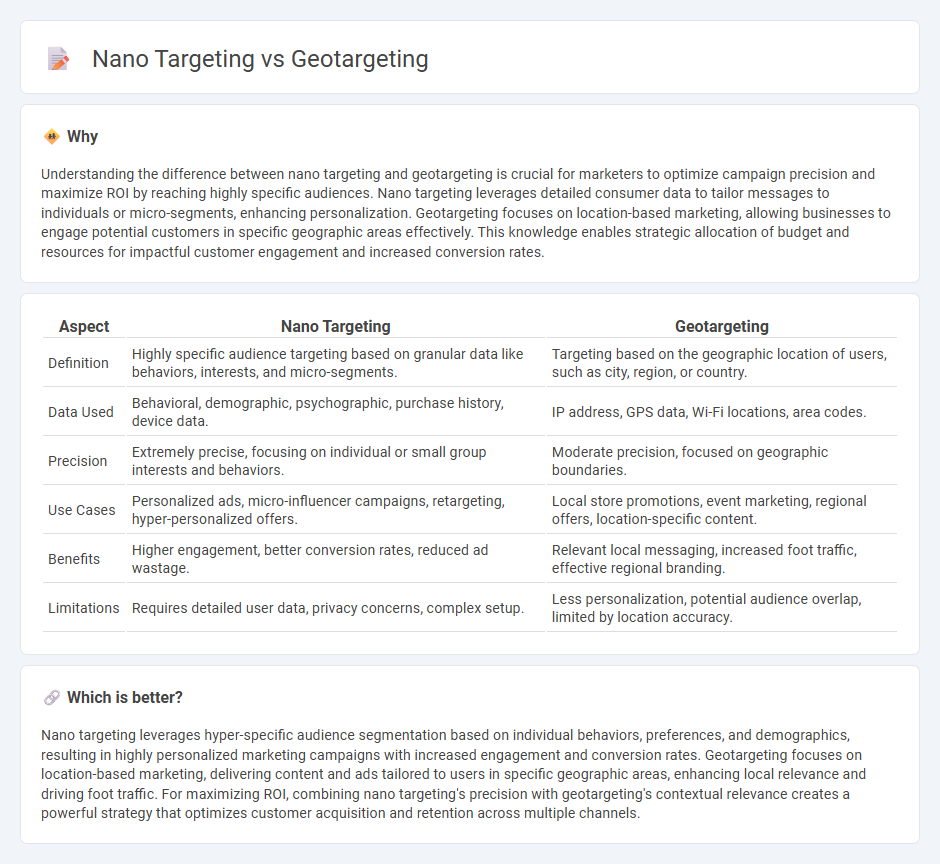
Nano targeting focuses on hyper-specific audience segments based on detailed personal data and behaviors, enabling highly personalized marketing campaigns. Geotargeting narrows down potential customers by their geographic location, optimizing local relevance and timely offers. Explore the advantages of nano targeting and geotargeting to enhance your marketing strategy.
Why it is important
Understanding the difference between nano targeting and geotargeting is crucial for marketers to optimize campaign precision and maximize ROI by reaching highly specific audiences. Nano targeting leverages detailed consumer data to tailor messages to individuals or micro-segments, enhancing personalization. Geotargeting focuses on location-based marketing, allowing businesses to engage potential customers in specific geographic areas effectively. This knowledge enables strategic allocation of budget and resources for impactful customer engagement and increased conversion rates.
Comparison Table
| Aspect | Nano Targeting | Geotargeting |
|---|---|---|
| Definition | Highly specific audience targeting based on granular data like behaviors, interests, and micro-segments. | Targeting based on the geographic location of users, such as city, region, or country. |
| Data Used | Behavioral, demographic, psychographic, purchase history, device data. | IP address, GPS data, Wi-Fi locations, area codes. |
| Precision | Extremely precise, focusing on individual or small group interests and behaviors. | Moderate precision, focused on geographic boundaries. |
| Use Cases | Personalized ads, micro-influencer campaigns, retargeting, hyper-personalized offers. | Local store promotions, event marketing, regional offers, location-specific content. |
| Benefits | Higher engagement, better conversion rates, reduced ad wastage. | Relevant local messaging, increased foot traffic, effective regional branding. |
| Limitations | Requires detailed user data, privacy concerns, complex setup. | Less personalization, potential audience overlap, limited by location accuracy. |
Which is better?
Nano targeting leverages hyper-specific audience segmentation based on individual behaviors, preferences, and demographics, resulting in highly personalized marketing campaigns with increased engagement and conversion rates. Geotargeting focuses on location-based marketing, delivering content and ads tailored to users in specific geographic areas, enhancing local relevance and driving foot traffic. For maximizing ROI, combining nano targeting's precision with geotargeting's contextual relevance creates a powerful strategy that optimizes customer acquisition and retention across multiple channels.
Connection
Nano targeting and geotargeting both enhance marketing precision by focusing on narrowly defined audience segments based on specific attributes or locations. Nano targeting refines audience selection to highly detailed characteristics, while geotargeting narrows this focus by delivering content tailored to users' geographic locations. Together, they enable marketers to create hyper-personalized campaigns that increase engagement and conversion rates by addressing unique local and individual preferences.
Key Terms
Location Data
Geotargeting leverages precise location data such as GPS coordinates, IP addresses, or Wi-Fi signals to deliver content tailored to specific geographic areas, enhancing relevance for users in regions, cities, or neighborhoods. Nanotargeting goes a step further by combining hyper-local location data with demographic, behavioral, and context-driven insights to micro-segment audiences on a granular level, optimizing ad spend and engagement. Explore how integrating advanced location data technologies can revolutionize your targeted marketing strategies.
Audience Segmentation
Geotargeting segments audiences based on geographic location, enabling businesses to tailor content and advertisements to specific regions, cities, or countries, which enhances local relevance and engagement. Nanotargeting dives deeper by analyzing granular data such as individual behaviors, preferences, and micro-demographics to deliver highly personalized messages that drive conversion rates. Explore more to understand how these audience segmentation strategies can optimize your marketing campaigns and maximize ROI.
Personalization
Geotargeting leverages location data to display content or ads tailored to specific geographic areas, enhancing relevance by considering regional preferences and local trends. Nanotargeting delves deeper into individual-level data, combining behavioral, demographic, and psychographic insights for hyper-personalized marketing messages that resonate on a personal scale. Explore the nuances of how precise personalization in geotargeting and nanotargeting can transform your marketing strategy.
Source and External Links
Geotargeting - Geotargeting is a method used to deliver different content or ads based on a visitor's geolocation, which includes criteria like country, region, city, or IP address.
Geotargeted Marketing - Geotargeted marketing involves delivering content within specific geographic boundaries, often using location data combined with customer behavior and demographics to personalize ads.
Geotargeting in Retail - Geotargeting in retail allows businesses to deliver customized content based on a customer's location, using methods like IP addresses or GPS signals to tailor marketing efforts.
 dowidth.com
dowidth.com